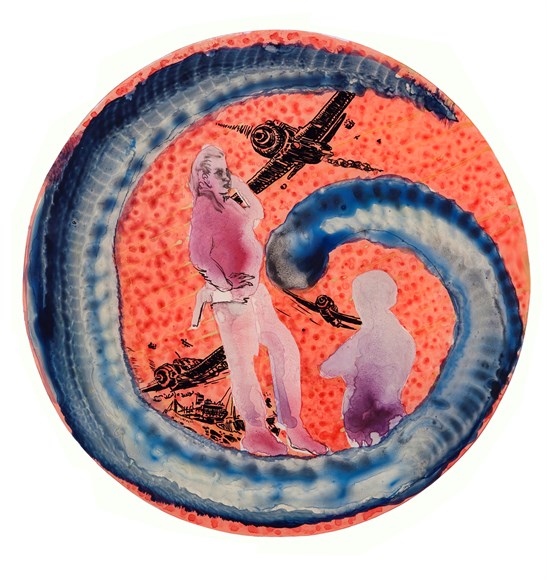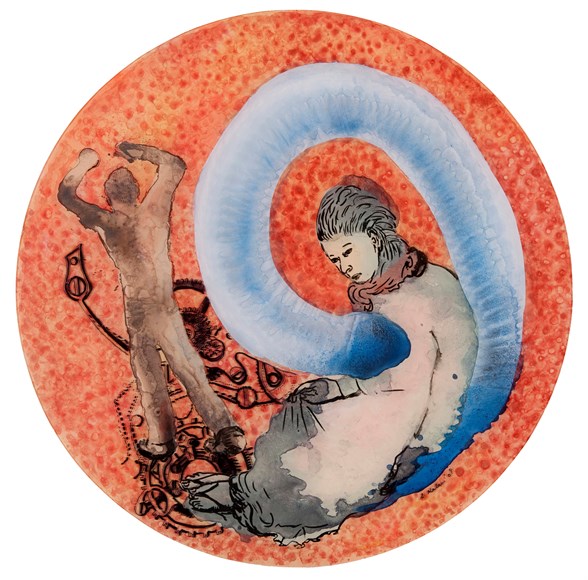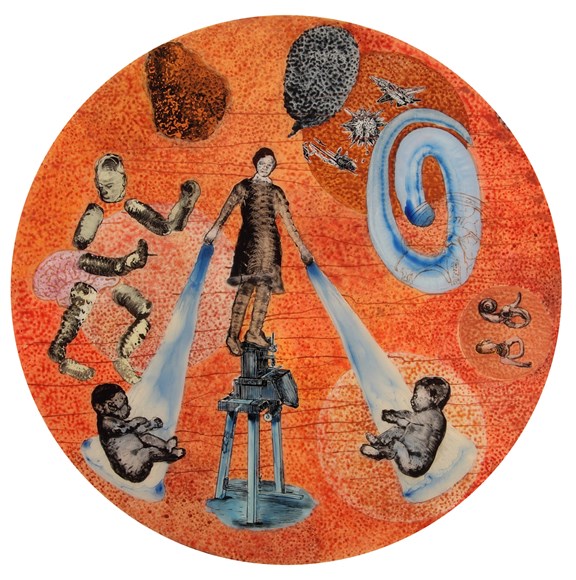Artist Spotlight: Nalini Malani
08.04.2019—
Nalini Malani, born in 1946 in Karachi, Pakistan, is one of the most influential contemporary artists working in India today. She was born just one year before the Partition of India. Her work is imbued by her experience as a refugee.
The Partition of India in 1947 divided the country into two independent nations: India and Pakistan. The separation displaced more than 14 million refugees and was accompanied by violence and disputes, which affect the region to this day.
Malani’s family was forced to flee from Pakistan to India where they endured cultural dislocation. Malani’s life was marked by the suffering and horrors which are illustrated in her drawings. When asked about the Partition Malani states, “I am more interested in how Partition activates itself in the present moment.” When reflecting on the effects Malani states, “It’s not my trauma but I have grown up with the smell of those cities. Their aura.”
Malani's practice is composed of a diverse range of mediums such as film, theater, and literature. However, the foundation of her work is drawing and painting. Her technique is known as "reverse painting" where she paints on clear sheets with ink and acrylic, and once finished, she flips the sheets. This method creates a tactile surface and with transparent figures. She often hangs the works in space, and uses motion and light projection to activate shadows and produce a unique viewing experience where real bodies intertwine with projected ones.
Drawing form archetypes presented in oriental cultures and in Greek mythology, curator Carolyn Christov-Bakargiev explains, “Malani’s work concerns making visible the invisible, foregrounding the shadows, blending the documentary and the urgent with the mythical and universal. To be born in Karachi in 1946 of a Sikh mother and a Theosophist father, means to have entered a world in crisis, tormented by the consequences of colonialism, world wars and their aftermath with huge populations in forced movement, yet with the cosmopolitan and worldly transnational emancipatory knowledges of theosophists such as Annie Besant, whose visions of an interrelated universe of thought forms prefigured later Quantum physics. Malani’s family, like many others, was forced to flee during Partition, and her early life was marked by those times to the degree that her imagery surfaces as the return of repressed psychic material, or appears to be vomited up from the depths of a subconscious filled with horrors and trauma.”
Many of her works look grotesque with evil looking creatures. The figures in her work are mostly women . She focuses attention on female traumas suach as the pains of birth. Her work in the Tiroche DeLeon Collection titled Warriors and Green Worm, 2009, features a gigantic larva which looks like an earthworm creature as a bomber plane hums in the background. At the center of the work is a woman standing looking ahead as the planes and earthworm swirl around her. This work may be looking at the exploitation of nature as the slug-like create tries to claim its space.

Nalini Malani, Warriors and Green Worm, 2009
Malani’s art focuses on the traditions of gender and identity. Her works connect to the violence inflicted upon women’s bodies and illustrate them in a way that look like medical painting’s or ancient imaginative maps. Her style looks at figures of mythological and literary traditions, for example, her work Broken #2, 2009, holds a plethora of forms and subjects. The reverse painting allows Malani to create multiple textures. The horizontal lines tearing across the painting are like water, rain or even blood, leaving streaks. The central figure is the female protagonist that appears in nearly all of her works. She stands on a machine giving life to two fetuses or possibly watching them die, while dismembered body parts and skulls stay floating as in a dreamscape. The dichotomy of life and death in this work is compelling and vicious.

Nalini Malani, Time, 2009
As a feminist, Malani worked with the infamous New York AIR Gallery. Since visiting the gallery in 1979, her work focused on the voice of silenced women, taking notions from great works of literature. In Time, 2009, the earthworm (a recurring motif in her work) resembles an umbilical cord around a severed neck of a woman. Her work addresses Indian history and culture while reflecting on war and the phantoms of religion. Her helplessness is imminent with her posture as if succumbing to a giant serpent. The spotted background in these works looks like an enlarged blood cell or a tumorous gland. The application of color creates depth, like that of a sphere.

Nalini Malani, Broken #2, 2009
Her works in new media often take the form of monumental and immersive shadow play pieces that create mesmerizing layers of imagery and sound. Committed to the role of the artist as social activist, Malani focuses on creating dynamic visual stories about those who have been ignored, forgotten, or marginalized by history. Drawn from history, culture, and her direct experience as a refugee of the Partition of India and the legacy of colonialism and de-colonization, Malani’s work explores violence, the feminine, and the politics of national identity.
Malani’s work is represented in numerous public collections worldwide including the Asia Society Museum, New York; Centre Pompidou, France; Museum of Modern Art, New York; National Gallery of Modern Art Mumbai, India; National Gallery of Modern Art New Delhi, India; British Museum, England; and Stedelijk Museum, The Netherlands. Malani recently presented major solo exhibitions including The Rebellion of the Dead: Retrospective 1969-2018, which showed in two parts at the Centre Pompidou, Paris, France (2017) and Castello di Revoli, Turin, Italy (2018); the Stedelijk Museum, The Netherlands (2017); Institute of Contemporary Art Boston, Massachusetts (2016); Kiran Nader Museum of Art, India (2014); Art Gallery of New South Wales, Australia (2012); Musée Cantonal des Beaux-Arts, France (2010); and Irish Museum of Modern Art, Ireland (2007).
news archive
Map Feature
June 1, 2013—We are proud to incorporate a new feature to our website:
View the collection on Map
Artist spotlight: Liu Wei
March 26, 2014—Having recently acquired a 3rd work by Liu Wei, we dedicate a spotlight to one of China’s most revered contemporary artists.
Read More »Artist Spotlight: Ruijun Shen
April 1, 2017—The Tiroche DeLeon Collection recently acquired two magnificently intricate works by the promising artist and curator Ruijun Shen. We are pleased to dedicate this next spotlight to her.
Read More »


